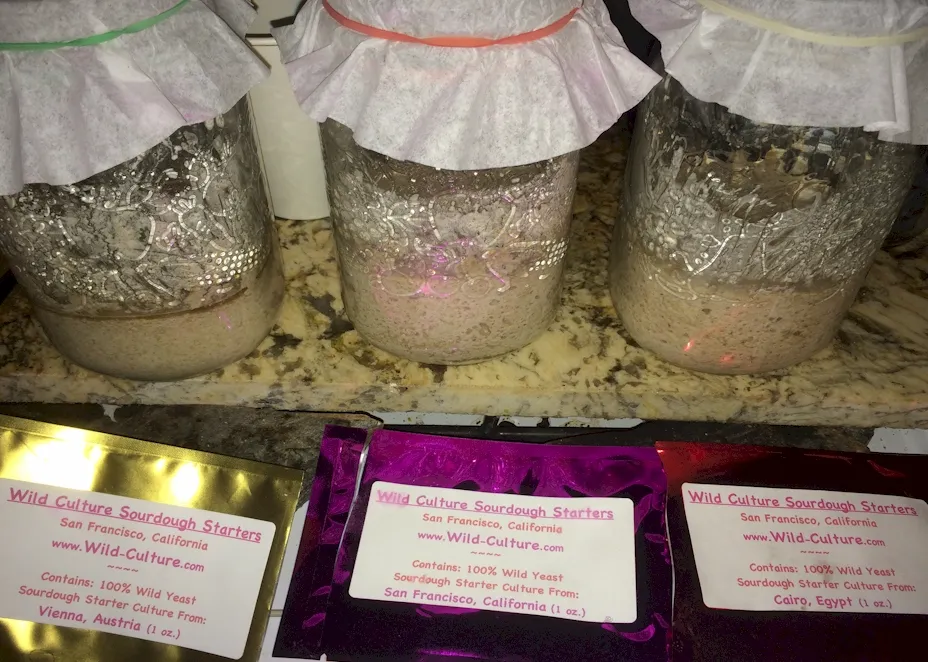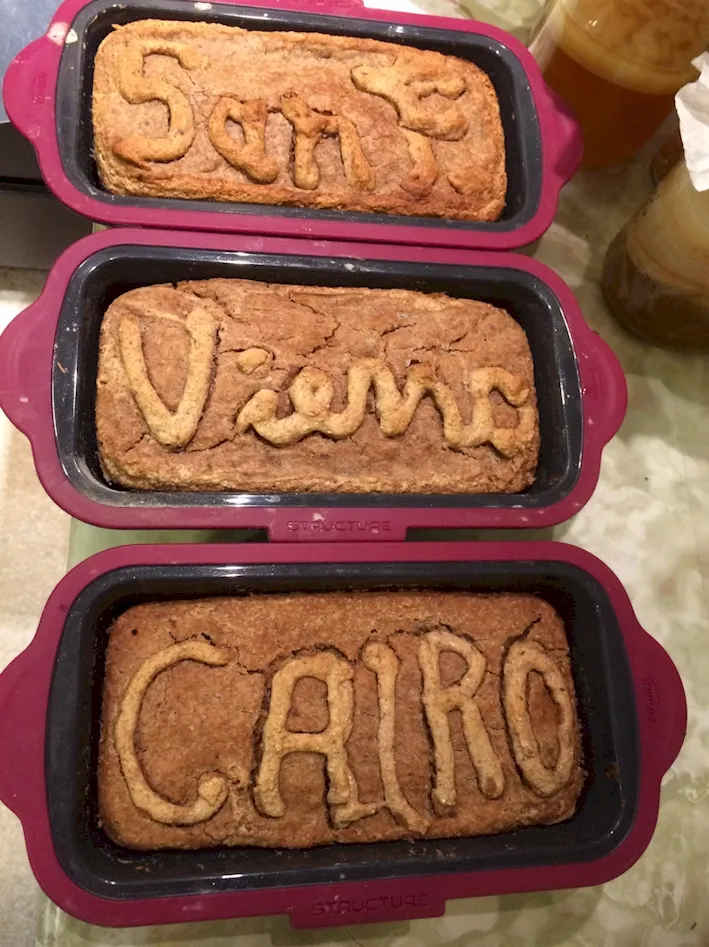Sourdough
Sourdough Starters From Around The World

Table of Contents
Daniel’s Recipe
Daniel’s Rule: It is totally not necessary to follow any directions or recipe to a “T”.
FIRST- Get your starter on. Take it out of the fridge, drain off top watery stuff (may be black and have slight mold). Stir and remove enough that you can add a portion of flour mixed with water (one TBSP, 1/4 C whatever…it depends on the size of your container). Stir furiously, leave covered with coffee filter in warm location on plate or bowl (in case it expands too much). Repeat every 8-16 hrs until you can see it bubbling nicely. It may take 3 days!!!
SECOND- Make pile of flour & pinch of salt, pour a bunch of starter (about 2 parts starter to 1 part water) mix until you knead to.
THIRD- Let rise (“proof”) as long as you want (6 -18 hrs) to have the lactic acid bacteria do their thing.
FOURTH- Bake for only 20-40 min depending on thickness at about 400.
Easy—peasy! It’s pretty hard to wreck bread and so much fun to get really good at it!

Research
Benefits of Sourdough Article
Mon, Jan 16, 2017
Here’s a summary of the many benefits of sourdough, as revealed by research done in the past fifteen years:
• Basic life preservation of grains is to be indigestible, thus pass through an animal as a pre-fertilized seed, ready to grow. These indigestible compounds are great for ensuring the plants continued fertility, but they can be harmful to humans, especially in large amounts. Up to 100 years ago all bread was fermented and/or sprouted to allow us to digest easier. It has been bypassed by our need for speed, and now de-nutriented faster grains and toxic chemicals make getting nutrients from veggies much harder. If we are to eat bread/pasta, let us do it the safe way.
• Sourdough LAB can modify the bits of gliadin and glutenin protein in wheat flour that are toxic to people with coeliac disease (CD) and non-coeliac gluten sensitivity. This doesn’t mean CD sufferers can eat all (or even any) sourdough bread. It does mean that there is a time-honoured method for making wheat flour more digestible and that we urgently need to know which types of bread on sale in the shops deploy this to real effect.
• LAB (including those commonly found in sourdough bread) produce beneficial compounds: antioxidants, the cancer-preventive peptide lunasin, and anti-allergenic substances, some of which may help in the treatment of auto-immune diseases. Interestingly, these by-products seem able to survive heating, suggesting that baked sourdough bread may have ‘probiotic’ potential by stimulating immune responses in the gut.
• Bread, especially if made with unrefined flour, is a significant source of dietary minerals such as iron, calcium, magnesium and zinc. But a slice of fast-made wholemeal may be nutritious only in theory if its contents pass straight through the body without being absorbed. The main culprit here is phytic acid, present in the bran layers of cereals, which ‘locks up’ the important minerals. Several hours of fermentation with sourdough is sufficient to neutralise phytic acid and make the minerals more bioavailable.
• Problematic protein fragments are not the only thing in bread that we might want to reduce to a minimum. Acrylamide, a suspected carcinogen, can be found in bread crusts. Long fermentation, typical of sourdough systems, can reduce levels of the amino-acid asparagine that is a precursor of acrylamide formation.
• Bread is often avoided by those affected by weight-gain and metabolic syndrome — rightly, perhaps, in the case of industrial white loaves with a high glycaemic index (GI). But sourdough LAB produce organic acids that, under the heat of baking, cause interactions that reduce starch availability. The lowest GI breads are whole-grain sourdoughs with a compact texture.
© Andrew Whitley 2013
http://www.breadmatters.com/index.php?route=information/information&information_id=34
Sourdough Links
| What is Sourdough? The Benefits of Sourdough Bread | http://dontwastethecrumbs.com/2013/06/what-is-sourdough-benefits-of-sourdough-bread/ |
| The Benefits of Sourdough | http://www.breadmatters.com/ |
| 5 Reasons To Make Sourdough Your Only Bread | http://realfoodforager.com/5-reasons-to-make-sourdough-your-only-bread/ |
| Could sourdough bread be the answer to the gluten sensitivity epidemic? (The Guardian) | https://www.theguardian.com/lifeandstyle/2016/mar/23/sourdough-bread-gluten-intolerance-food-health-celiac-disease |
| Giving Up Gluten? Why You Should Say Hello To Sourdough | http://www.mindbodygreen.com/0-12354/giving-up-gluten-why-you-should-say-hello-to-sourdough.html |
| Sourdough and digestibility - Sustainable Food Trust | http://sustainablefoodtrust.org/articles/sourdough-and-digestibility/ |
| Highly efficient gluten degradation by lactobacilli and fungal proteases during food processing: new perspectives for celiac disease | https://www.ncbi.nlm.nih.gov/pubmed/17513580 |
| Moderate decrease of pH by sourdough fermentation is sufficient to reduce phytate content of whole wheat flour through endogenous phytase activity | https://www.ncbi.nlm.nih.gov/pubmed/15631515 |
| Making bread with sourdough improves mineral bioavailability from reconstituted whole wheat flour in rats | https://www.ncbi.nlm.nih.gov/pubmed/12781853 |
| Fermentation Reduces Free Asparagine in Dough and Acrylamide Content in Bread | http://aaccipublications.aaccnet.org/doi/abs/10.1094/CCHEM.2004.81.5.650?journalCode=cchem |
| Acrylamide is classified as an extremely hazardous substance | https://en.wikipedia.org/wiki/Acrylamide |
| Super Easy Gluten Free Sourdough Starter | http://wholenewmom.com/recipes/gluten-free-sourdough-starter/ |
| 15 Sourdough Breads To Try: (Baking) | http://tipnut.com/sourdough-bread/ |
| Bread machines seem versatile | http://www.explainthatstuff.com/breadmaker.html |